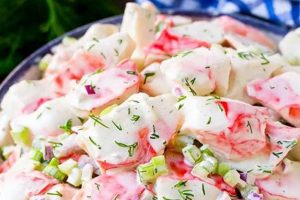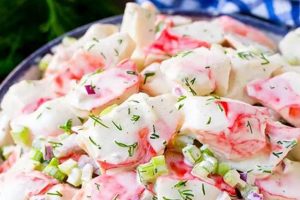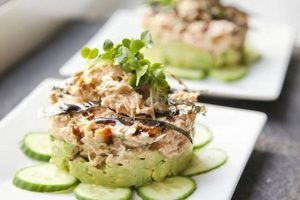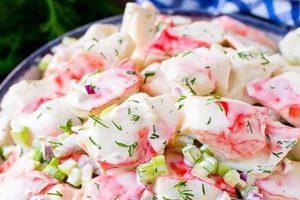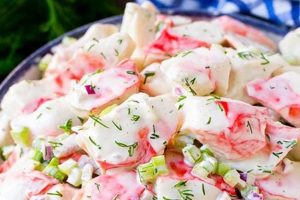A crab salad prepared without mayonnaise offers a lighter alternative to the traditional version. It typically features crab meat combined with other ingredients like celery, onion, and various seasonings, often dressed with a vinaigrette or a lighter, mayonnaise-free sauce. This approach emphasizes the natural flavor of the crab while accommodating dietary restrictions or preferences for lower-fat options. Example preparations might include a lemon-herb vinaigrette, a Greek yogurt-based dressing, or even a simple olive oil and vinegar combination.
This style of preparation offers several advantages. By eliminating mayonnaise, the overall calorie and fat content is reduced, making it a healthier choice. Furthermore, a lighter dressing allows the delicate flavor of the crab to shine through. Historically, mayonnaise-based salads emerged with advancements in refrigeration. Prior to this, lighter, often vinegar-based, dressings were more prevalent. Thus, these lighter variations can be seen as a return to more traditional methods of salad preparation, highlighting fresh ingredients and simple flavors. This approach also offers greater flexibility in flavor profiles, allowing for experimentation with diverse herbs, spices, and citrus elements.
This discussion will further explore various approaches to crafting such salads, including specific ingredient combinations, recommended preparation methods, and serving suggestions.
Tips for Crafting Mayonnaise-Free Crab Salad
Achieving a flavorful and satisfying crab salad without mayonnaise requires careful consideration of ingredient selection and preparation techniques. The following tips offer guidance for creating a successful dish.
Tip 1: Fresh Crab is Key: Opt for the highest quality crab meat available. Freshly picked crab provides optimal flavor and texture. Canned crab can be used, but ensure it’s well-drained and rinsed to remove any excess liquid or “canned” taste.
Tip 2: Balance Moisture Content: Ingredients like celery and onion add flavor and texture, but excess moisture can dilute the dressing and overall flavor. Finely dice these ingredients and consider lightly salting them to draw out excess water before incorporating them into the salad.
Tip 3: Acid is Essential: A vibrant dressing requires acidity. Lemon or lime juice, vinegar, or a combination thereof, provide brightness and balance the richness of the crab.
Tip 4: Embrace Herbs and Spices: Fresh herbs like dill, parsley, chives, or tarragon complement the flavor of crab. A pinch of cayenne pepper or Old Bay seasoning can add a touch of heat and complexity.
Tip 5: Consider Texture: A variety of textures adds interest. Chopped bell peppers, water chestnuts, or even a small amount of finely diced apple can provide contrasting crispness.
Tip 6: Dress Lightly and Adjust: It’s best to start with a smaller amount of dressing and add more as needed. Overdressing can mask the flavor of the crab.
Tip 7: Chill Before Serving: Allowing the salad to chill in the refrigerator for at least 30 minutes allows the flavors to meld and enhances the overall experience.
By following these guidelines, one can create a crab salad that is not only lighter and healthier but also bursting with fresh, vibrant flavors. Careful attention to ingredient quality and balancing flavors and textures ensures a successful and satisfying dish.
These tips provide a foundation for creating exceptional mayonnaise-free crab salads. Experimentation with different flavor combinations and ingredients can lead to personalized variations suited to individual preferences.
1. Fresh, High-Quality Crabmeat
In the realm of mayonnaise-free crab salads, the quality of the crabmeat reigns supreme. Its freshness directly impacts the overall flavor profile, texture, and enjoyment of the dish. Utilizing substandard crab can compromise even the most carefully crafted vinaigrette or thoughtfully selected accompanying ingredients. This section will explore the facets of selecting and utilizing premium crabmeat for optimal results.
- Sourcing and Selection
Sourcing crab from reputable fishmongers or markets specializing in seafood ensures access to higher-quality product. Look for crabmeat that is moist, firm, and exhibits a vibrant, natural color. Avoid crab that appears dry, discolored, or has a strong fishy odor. Inquiries about the crab’s origin and harvesting methods can provide additional insights into its quality and freshness.
- Impact on Flavor Profile
Fresh, high-quality crabmeat possesses a delicate sweetness and subtle brininess that shines through in the absence of mayonnaise. This inherent flavor allows the nuanced notes of the accompanying ingredients and dressing to complement, rather than mask, the taste of the crab. Conversely, lower-quality crabmeat often exhibits a pronounced fishy flavor that can detract from the overall balance of the salad.
- Textural Considerations
Premium crabmeat exhibits a firm yet delicate texture that contributes to the salad’s overall appeal. This textural integrity holds up well when combined with other ingredients and dressings, preventing the crab from becoming mushy or disintegrating. Inferior crabmeat often lacks this desirable texture, resulting in a less satisfying culinary experience.
- Shelf Life and Storage
Proper storage is crucial for preserving the freshness and quality of crabmeat. Fresh crabmeat should ideally be used within a day or two of purchase. If immediate use isn’t feasible, storing it tightly wrapped in the coldest part of the refrigerator helps maintain its quality. Freezing fresh crabmeat is possible, but it can impact texture, making it better suited for dishes where texture is less critical.
Ultimately, the investment in fresh, high-quality crabmeat yields significant returns in the final dish. The superior flavor, texture, and overall quality elevate the crab salad from ordinary to exceptional, justifying the emphasis on sourcing the best ingredients. This attention to detail ensures a truly satisfying and memorable culinary experience, showcasing the delicate nuances of the crab in the absence of masking ingredients like mayonnaise.
2. Light, Flavorful Dressing
The absence of mayonnaise in crab salad necessitates a dressing that provides both flavor and moisture without overpowering the delicate taste of the crab. A heavy, creamy dressing would mask the subtle sweetness and brininess of the crab, while a bland dressing would render the salad uninspired. Light, flavorful dressings offer the ideal solution, enhancing the crab’s natural flavors while adding their own complementary notes. This approach allows the crab to remain the star of the dish, supported, not overshadowed, by the other components. For example, a lemon-herb vinaigrette adds brightness and freshness, while a Greek yogurt-based dressing provides a tangy creaminess without the heaviness of mayonnaise.
The choice of dressing significantly impacts the overall sensory experience of the salad. A vinaigrette, with its sharp acidity and herbaceous notes, cuts through the richness of the crab, creating a refreshing and balanced flavor profile. The oil in the vinaigrette also contributes to a pleasant mouthfeel, compensating for the lack of mayonnaise. Alternatively, a yogurt-based dressing offers a different textural element, introducing a subtle creaminess that complements the flaky crabmeat. The tanginess of the yogurt further enhances the flavor complexity of the salad. Other options, such as a light citrus-based dressing or even a simple olive oil and herb mixture, provide further avenues for flavor exploration, catering to diverse palates and dietary preferences. The variability inherent in dressing choices allows for customization and creativity, transforming a simple crab salad into a culinary canvas.
Successfully crafting a mayonnaise-free crab salad hinges on the selection and execution of a suitable dressing. The dressing serves as a unifying element, binding the ingredients together and imparting essential moisture and flavor. By understanding the role and impact of the dressing, one can elevate the dish from merely acceptable to genuinely exceptional. Challenges might arise in balancing the desired flavor intensity with the need for lightness. Experimentation with different acid-to-oil ratios in vinaigrettes or adjusting the herbs and spices in yogurt-based dressings allows for fine-tuning and personalization. Ultimately, a thoughtfully chosen and well-executed dressing elevates the crab salad, transforming it into a dish that celebrates the inherent flavors of fresh seafood.
3. Crisp, Complementary Vegetables
Within the context of a mayonnaise-free crab salad, the strategic incorporation of crisp, complementary vegetables assumes a crucial role. These vegetables contribute not only textural complexity but also enhance the overall flavor profile, counterbalancing the richness of the crab while adding nutritional value. Their presence elevates the salad from a simple protein-based dish to a more balanced and satisfying culinary experience. Careful selection and preparation of these vegetables are essential to achieving the desired outcome.
- Textural Contrast and Enhancement
The inherent tenderness of crab meat benefits from the inclusion of vegetables that offer a contrasting crispness. Celery, for example, provides a satisfying crunch, while finely diced bell peppers introduce a subtle snap. This interplay of textures creates a more dynamic and engaging culinary experience, preventing the salad from becoming monotonous. The contrasting textures also contribute to a more satisfying mouthfeel.
- Flavor Balancing and Enhancement
Beyond texture, crisp vegetables contribute distinct flavor notes that complement the delicate sweetness of the crab. The subtle bitterness of celery, the peppery bite of radishes, or the mild sweetness of diced cucumber each provide a counterpoint to the richness of the crab, creating a more balanced and nuanced flavor profile. These vegetables can also enhance the overall freshness of the salad.
- Nutritional Enrichment
Incorporating a variety of crisp vegetables elevates the nutritional value of the crab salad. These vegetables provide essential vitamins, minerals, and dietary fiber, contributing to a more wholesome and balanced meal. This aspect is particularly relevant in health-conscious preparations, where the absence of mayonnaise already reduces the fat and calorie content.
- Visual Appeal and Presentation
The vibrant colors and varied shapes of crisp vegetables contribute to the visual appeal of the salad. The bright green of celery, the red of bell peppers, or the deep purple of red onion add visual interest, enhancing the presentation and making the salad more enticing. This aspect is particularly relevant when serving the salad for guests or special occasions.
The inclusion of crisp, complementary vegetables in a mayonnaise-free crab salad proves essential for achieving both textural and flavor balance. These vegetables not only enhance the sensory experience but also contribute to the nutritional value and visual appeal of the dish. Their careful selection and preparation are therefore integral to crafting a successful and satisfying crab salad that highlights the delicate flavors of the crab while offering a lighter, healthier alternative to traditional mayonnaise-based versions.
4. Balanced Seasonings and Herbs
In a crab salad recipe without mayonnaise, the role of seasonings and herbs becomes paramount. Without the richness and inherent flavor of mayonnaise, the delicate flavor of the crab meat becomes more prominent, requiring careful balancing with complementary seasonings and herbs. This approach necessitates a nuanced understanding of flavor pairings and the impact of individual spices and herbs on the overall composition of the salad.
- Emphasis on Fresh Herbs
Fresh herbs provide brightness and complexity to crab salad. Dill, parsley, chives, and tarragon are excellent choices, offering distinct aromatic profiles that complement the crab’s subtle sweetness. Overuse can easily overpower the delicate crab flavor; restraint and balance are key. For instance, a chiffonade of fresh dill adds a subtle anise note that enhances the crab’s natural brininess without masking it, while a sprinkle of chopped chives provides a mild onion flavor that adds depth.
- The Role of Spices
Spices like Old Bay seasoning, paprika, or a pinch of cayenne pepper introduce warmth and depth. Old Bay, with its blend of celery salt, paprika, and other spices, provides a savory complexity that complements the crab beautifully. Cayenne adds a touch of heat, balancing the sweetness of the crab and other ingredients. However, it’s crucial to use spices judiciously to avoid overwhelming the delicate crab flavor. A light hand ensures that the spices enhance rather than dominate the overall taste profile.
- Balancing Salt and Acid
The delicate flavor of crab requires careful balancing of salt and acid. A touch of sea salt enhances the natural sweetness of the crab, while a squeeze of lemon or lime juice provides brightness and cuts through any richness. This balance is crucial in a mayonnaise-free version, as the absence of mayonnaise removes a layer of flavor and texture that could otherwise mask imbalances. The acidity also helps to preserve the freshness of the crab.
- Enhancing, Not Masking, Crab Flavor
The primary goal of seasoning a mayonnaise-free crab salad is to enhance, not mask, the natural flavor of the crab. A thoughtful approach to seasoning allows the delicate sweetness and brininess of the crab to shine through while adding layers of complexity and depth. This approach contrasts with mayonnaise-based versions where the mayonnaise itself contributes significant flavor, potentially masking subtle nuances in the crab and other ingredients. In a mayonnaise-free version, each seasoning plays a more distinct role, contributing to the overall flavor balance.
Crafting a balanced flavor profile in a mayonnaise-free crab salad hinges on the judicious use of seasonings and herbs. The absence of mayonnaise necessitates a more nuanced approach, focusing on enhancing the natural flavors of the crab rather than masking them. By understanding the interplay between different herbs, spices, salt, and acid, one can create a crab salad that is not only lighter and healthier but also showcases the delicate and nuanced flavors of fresh crab.
5. Proper Chilling and Storage
Proper chilling and storage are critical for maintaining the quality and safety of crab salad made without mayonnaise. Because mayonnaise acts as a preservative in traditional crab salad, its absence in this recipe necessitates heightened attention to temperature control. Crab meat is highly perishable and susceptible to bacterial growth, particularly at warmer temperatures. Failing to maintain appropriate chilling during preparation and storage can lead to spoilage, significantly impacting flavor and potentially causing foodborne illness. For example, leaving the prepared salad at room temperature for an extended period, particularly in warmer climates, can create an environment conducive to rapid bacterial proliferation.
The process of chilling begins immediately after preparing the crab salad. Prompt refrigeration at or below 40F (4C) inhibits bacterial growth and preserves freshness. Storing the salad in a sealed, airtight container further minimizes exposure to air and potential contaminants. This practice maintains the desired texture and prevents the absorption of off-flavors from other foods in the refrigerator. Furthermore, any ingredients used in the salad, such as fresh vegetables and herbs, also benefit from proper chilling, retaining their crispness and vibrancy. When transporting the salad, maintaining a cold environment is crucial. Using an insulated cooler with ice packs ensures the salad remains adequately chilled, preventing bacterial growth during transit.
In summary, omitting mayonnaise from crab salad necessitates meticulous attention to chilling and storage practices. Rapid cooling and consistent refrigeration at appropriate temperatures are essential for maintaining the salad’s quality, flavor, and, most importantly, safety. Neglecting these practices compromises the dish and poses potential health risks. Understanding the heightened perishability of crab salad without mayonnaise underscores the importance of proper temperature control throughout the preparation and storage process. This awareness allows for informed decisions regarding preparation timing, serving methods, and storage duration, ultimately contributing to a safe and enjoyable culinary experience.
6. Creative presentation options
Presentation elevates crab salad without mayonnaise from a simple dish to a culinary experience. Beyond flavor, visual appeal significantly impacts enjoyment. Thoughtful presentation enhances perceived value and stimulates appetite, crucial for lighter dishes where richness isn’t the primary draw. Creative presentation options compensate for the absence of mayonnaise’s visual texture, adding interest and sophistication.
- Individual Portions
Serving crab salad in individual portions offers elegance and control. Examples include lettuce cups, avocado halves, or endive spears. These options provide fresh, contrasting flavors and textures, complementing the crab. Portioning also allows for precise ingredient distribution, ensuring each serving delivers a balanced experience and avoids the “soggy bottom” issue common in large bowls of undressed salad.
- Stacked Presentations
Vertical arrangements add height and visual interest. Examples include layering crab salad between cucumber slices, stacking it on toasted baguette rounds, or using a ring mold for defined portions. Stacking offers architectural appeal and showcases ingredient layers, highlighting the salad’s components and contrasting textures. This approach is particularly effective for showcasing vibrant vegetables and herbs within the salad.
- Garnishes and Accompaniments
Garnishes enhance visual appeal and flavor. Fresh herbs, edible flowers, microgreens, or a sprinkle of paprika add color and texture. Accompaniments like crackers, toasted points, or crudits offer textural contrast and dipping opportunities. These elements elevate the dining experience, turning a simple salad into a more engaging and sophisticated presentation. Lemon wedges offer a burst of freshness and a visual cue to the citrus notes within the salad.
- Serving Vessels
The choice of serving dish influences perception. A chilled metal bowl offers sleek modernity, while a rustic wooden bowl provides warmth and earthiness. Small glass dishes or ramekins emphasize individual portions and elegant simplicity. The serving vessel should complement the salad’s style and the overall dining setting. A bright white bowl emphasizes the salad’s vibrant colors and fresh ingredients.
Creative presentation significantly enhances the appeal of crab salad without mayonnaise. By focusing on visual elements and thoughtful arrangements, one transforms this lighter dish into a visually compelling and satisfying culinary experience. Strategic plating, portioning, and the use of garnishes compensate for the absence of mayonnaise, creating a dish that appeals to both the palate and the eye. This approach elevates the perceived value and overall enjoyment of the salad, proving that healthy and flavorful can also be beautiful and engaging.
Frequently Asked Questions
This section addresses common inquiries regarding crab salad prepared without mayonnaise, offering clarity and practical guidance for achieving optimal results.
Question 1: What are the key advantages of omitting mayonnaise from crab salad?
Eliminating mayonnaise reduces calorie and fat content, allows the crab flavor to shine, and offers versatility in flavor profiles through alternative dressings. This approach caters to health-conscious individuals and those seeking lighter, brighter flavors.
Question 2: What can be used as a substitute for mayonnaise in crab salad?
Suitable alternatives include vinaigrettes (lemon-herb, balsamic), Greek yogurt-based dressings, or simple combinations of olive oil, herbs, and citrus juices. These options provide moisture and flavor without the heaviness of mayonnaise.
Question 3: How does one prevent the salad from becoming too dry without mayonnaise?
Proper moisture balance relies on incorporating ingredients with inherent moisture, such as finely diced celery or bell peppers. Lightly salting these vegetables beforehand draws out excess water, preventing a watery salad. The dressing also contributes essential moisture.
Question 4: How long can crab salad without mayonnaise be stored safely?
Due to its perishability, refrigerate promptly at or below 40F (4C) in an airtight container. Consume within one to two days for optimal quality and safety. Prompt chilling is crucial for minimizing bacterial growth.
Question 5: Can canned crab be used for this type of salad?
While fresh crab is preferred, canned crab can suffice. Thoroughly drain and rinse the canned crab to remove excess liquid and any “canned” taste. Opt for high-quality canned crab packed in water or brine, avoiding varieties with added flavors or fillers.
Question 6: How can one elevate the presentation of mayonnaise-free crab salad?
Creative presentation enhances visual appeal. Consider serving in lettuce cups, avocado halves, or atop toasted baguette slices. Garnishing with fresh herbs or a sprinkle of paprika adds color and visual interest. Thoughtful plating elevates the dining experience.
Understanding these key aspects of mayonnaise-free crab salad preparation ensures a successful outcome. Prioritizing ingredient quality, proper handling, and creative presentation results in a flavorful, healthy, and visually appealing dish.
The following sections will delve into specific recipe variations and explore further culinary possibilities using this approach to crab salad preparation.
Crab Salad Recipe No Mayo
Exploration of crab salad recipes without mayonnaise reveals a departure from traditional preparations, emphasizing the inherent flavors of fresh crab. Careful ingredient selection, balanced seasonings, and thoughtful presentation elevate this lighter approach. Eliminating mayonnaise reduces caloric density while opening avenues for flavor exploration through diverse dressings and complementary vegetables. Emphasis on proper chilling and storage underscores the importance of food safety when omitting traditional preservatives. This approach caters to health-conscious consumers without sacrificing flavor or culinary creativity.
Crab salad recipes without mayonnaise represent a shift towards lighter, brighter flavors in contemporary cuisine. This culinary adaptation demonstrates the potential for reimagining classic dishes with a focus on fresh ingredients and balanced flavor profiles. Embracing such alternatives allows for exploration of diverse culinary traditions and a deeper appreciation for the natural flavors of high-quality ingredients. This approach encourages a broader perspective on culinary possibilities, emphasizing freshness, flavor, and mindful preparation.

